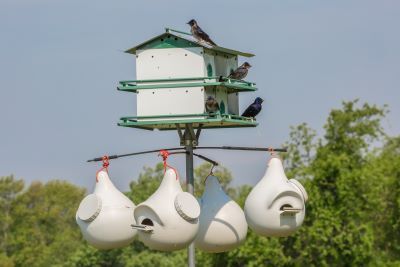
Good Natured: Purple Martins
According to the Cornell Lab of Ornithology, North America is home to 2,059 species of birds. Of these, 2,058 are pretty self sufficient. Sure, they could do without humans' constant interference, in the form of loud noises and bright lights at night, and the toxins and litter we seem to leave everywhere. But when it comes to the day-to-day of bird life, that is, finding food, water and shelter, those 2,058 different types of birds do just fine.
But there's one species whose eastern population is almost entirely dependent on us to provide it with the housing it needs to build nests and raise young. You've probably heard of it, and maybe even can recognize it, or at least the housing it requires. Yup, we're talking about purple martins.
(All right, I know some of you can make a pretty strong case for a couple other species, the chimney swift and the barn swallow, as also being reliant on manmade structures for nesting. But I'm going to split hairs here and say that while the swallows and swifts over time adapted their habitat preferences and moved, uninvited, into chimneys and barns, purple martins were actively recruited to live among humans. According to the Purple Martin Conservation Association, indigenous people began hanging up hollowed-out gourds to attract purple martins thousands of years ago. Naturalist Mark Catesby wrote of seeing martin houses on farms in the Carolinas in the early 1700s, and ornithologist Alexander Wilson described martins using gourds in Choctaw and Chickasaw villages in the late 1700s.)
Let's see, where were we?
Oh yes, the martins, and their reliance on us for housing. As secondary cavity nesters, they have a need for sheltered housing, but lack the means to excavate it themselves. Before humans came on the scene, purple martins nested in old woodpecker holes. But post-humans, the purple martins east of the Mississippi River have become tenants in gourds and houses made just for them.
(Time for another aside… You might be wondering what the big deal is about purple martins. Way back when, people realized that the martins excelled at feeding on insects. In addition, they also chased crows away from food crops and vultures away from drying meats and pelts. The PMCA folks also say there's conjecture that the birds, always alert to danger, may have acted as an early-warning system when strangers approached. With their up-with-the-sun ways, they might also have functioned as an alarm clock for early risers. And their bubbling songs and constant antics were no doubt a source of entertainment throughout the summer months.)
The National Wildlife Federation estimates that today more than 1 million people in the United States and Canada host purple martin colonies in large apartment-style complexes. Often referred to as landlords, the majority of these individuals devote considerable time and effort to keeping their housing in top condition for their birdie boarders.
If you've ever visited Hickory Knolls in St. Charles, you might have noticed the thriving colony of purple martins exists in a row of houses just north of our nature center, between the athletic fields and garden plots. Our dedicated volunteer, Mike Swanson, has maintained this complex for more than 20 years, meticulously monitoring the breeding pairs in the summer and performing maintenance and repairs during winter.
Another purple martin advocate is John Laskowski, assistant park superintendent at Moraine Hills State Park & McHenry Dam State Park. In his years as a martin landlord at McHenry Dam and, more recently, the Volo Bog State Natural Area, he's worked hard to ensure the birds have the housing they need and—more important—can rely on year after year.
Right now, he and his staff are busy prepping for the martins' return.
“Of the three boxes we have at the dam, two are down for maintenance and will go back up when we see or hear birds(martins) in the area. That's usually around late April," he says. “The third one needs to come down soon and get cleaned out too."
None of the boxes are on poles with pulleys, so raising and lowering is a time-consuming, two-man job. He notes that timing is important too. “Too soon and you get sparrows, too late and you'll miss the scouts (those birds that fly ahead to seek suitable housing)."
As successful as his team's colonies are, John sees a lot of martin houses at other locations that have no martins at all. Or, worse, host invasive house sparrows and starlings, both of which will kill purple martins.
Many reasons exist for these failures, but one the biggest is also an easy one to overlook: Tree encroachment. “I really think many people just don't know about how much influence trees have on the acceptance of housing for martins," John says. He adds that the birds might accept a tree within 20 to 30 feet, but no closer.
To further help the birds, and struggling landlords, John shared a PMCA article, The Top 12 Reasons Why People Lose Their Purple Martins. The full text can be accessed here: https://www.purplemartin.org/uploads/media/top12-258.pdf
If you or someone you know is struggling to attract or keep a purple martin colony, check out this important info. The birds, and fellow landlords, say thank you!
Pam Otto is the outreach ambassador for the St. Charles Park District. She can be reached at potto@stcparks.org.

